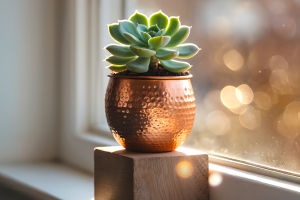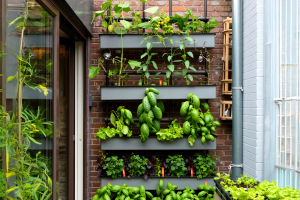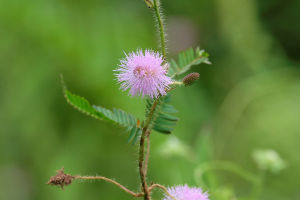You might buy plants to decorate a shelf, brighten a corner, or feel closer to nature—but did you know some of them can actually clean the air in your home?
While opening windows or using air purifiers helps, certain houseplants offer a natural boost by filtering harmful toxins you might not even realize are in your indoor environment.
But not all greenery does this equally. Let's dive into the real science of how plants purify air, and which ones are truly worth your time and space.
Indoor Air Isn't As Clean As You Think
It's easy to assume that indoor air is safer than outdoor air, but studies show otherwise. According to the U.S. Environmental Protection Agency (EPA), indoor air can be 2 to 5 times more polluted than outdoor air. Everyday sources like synthetic furniture, paints, cleaning products, and even your carpet can release volatile organic compounds (VOCs)—chemical particles that can affect your respiratory health, concentration, and sleep.
The most common indoor pollutants include:
1. Benzene – found in some plastics, paints, and glues.
2. Formaldehyde – released from pressed wood furniture and some cleaning products.
3. Trichloroethylene – present in dry-cleaned clothes or household cleaners.
4. Xylene and toluene – emitted by markers, paints, and nail polish.
Over time, exposure to these substances—especially in poorly ventilated rooms—can build up and affect your well-being.
How Plants Actually Clean Air
Back in 1989, NASA conducted a now-famous Clean Air Study to explore whether houseplants could remove pollutants from sealed space environments. Their findings were promising: certain plants could absorb VOCs through their leaves and roots, with help from soil microbes.
Here's how it works in simple terms:
1. Absorption through leaves: Plants take in gases during the process of respiration and photosynthesis. Some of those gases include harmful pollutants.
2. Filtration by roots and microbes: Once inside, some toxins move down to the roots and get broken down by beneficial soil microbes.
3. Moisture boost: Some plants also increase humidity through transpiration, which helps trap airborne dust and allergens.
Before you turn your home into a jungle, it's worth noting that most research was done in tightly controlled lab environments. In real homes, you'd need many plants per square foot to get a dramatic effect. Still, even a few carefully chosen plants can make a noticeable difference, especially in smaller or more enclosed spaces.
Best Plants for Air Purification
Some plants are just better than others when it comes to air cleaning. Here are five well-researched options that punch above their weight:
1. Spider Plant (Chlorophytum comosum)
Great for beginners, this plant filters carbon monoxide, formaldehyde, and xylene. It's also non-toxic to pets.
2. Snake Plant (Sansevieria trifasciata)
This sculptural beauty works overnight to release oxygen and remove toxins like formaldehyde and benzene.
3. Peace Lily (Spathiphyllum)
Not only is it visually striking, but it's also great at reducing ammonia, benzene, and trichloroethylene.
4. English Ivy (Hedera helix)
Known for its climbing vines, English ivy helps reduce airborne mold and fecal particles in the air.
5. Rubber Plant (Ficus elastica)
With large, glossy leaves, it's efficient at absorbing airborne chemicals and removing mold spores.
Tip: To boost effectiveness, choose a potting soil with active microbes and wipe leaves regularly, so pores don't get blocked by dust.
Where You Place Plants Matters
Air-purifying plants won't help much if they're sitting in a forgotten corner. Position them where you actually spend time and where pollutants tend to accumulate.
1. Bedrooms: Add a snake plant or peace lily to improve overnight air quality.
2. Living rooms: Place a rubber plant near electronics or large furniture to absorb chemical off-gassing.
3. Bathrooms: Ferns or ivy do well in high humidity and help reduce mold in the air.
4. Home offices: Use spider plants near your desk—they combat pollutants from computers, printers, and adhesives.
Ideally, place one medium-size plant per 100 square feet to see a noticeable benefit.
A Balanced View: Plants Help, But They're Not Magic
While houseplants can aid indoor air quality, it's important to manage expectations. Experts like Dr. Michael Waring, a professor of environmental engineering at Drexel University, note that the volume of air filtration from plants is limited in most real-life situations. For maximum effect, use plants alongside other good habits:
• Open windows when possible to encourage airflow
• Use low-VOC or eco-certified cleaning products
• Vacuum regularly with a HEPA filter
• Avoid overwatering plants to prevent mold buildup
Still, even if plants don't singlehandedly purify your air, they offer psychological benefits—lowering stress, improving focus, and making your home feel more alive.
Final Thought: It's About the Small Wins
No, one spider plant won't transform your entire home into a sterile air bubble. But a few well-placed plants can reduce airborne toxins, boost humidity, and give you a stronger connection to the natural world—without the need for electricity or monthly filter replacements.
Have you noticed a difference in your indoor air or mood after adding plants to your space? If so, which one made the biggest impact? Your experience might inspire someone else to start their own green journey—one leaf at a time.


